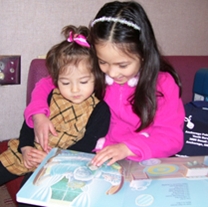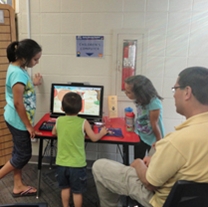 |
Recipient: Contact: Terrie Weckerle Web site: |
Recipient: Contact: Roy Bird Web site: www.kslib.info Grant: Supported by the IMLS Grants to States Program, Library Services and Technology Act |
||
Early literacy – everything children know about reading and writing before they can actually read and write – has become a focus of libraries nationwide. Evidence suggests that early language and pre-reading skills are a predictor of future school success.
In Alaska, nearly half of all young children enter kindergarten unprepared to read. With the assistance of an IMLS grant, the Ready to Read Resource Center is helping counteract this statistic by promoting early childhood literacy throughout the 49th state.
"Alaska is huge – it’s one-fifth the size of the contiguous U.S. We have towns, cities, and villages scattered all over the state," says Terrie Weckerle, project manager of the Center. Furthermore, "most of these locations don’t have direct road access – they can only be reached by air or by water."
With many Alaskan communities "having a hard enough time getting fresh fruits and vegetables to their citizens," adds Weckerle, "we thought we could be most helpful if we focused on the fact that many communities do not have ready access to quality, updated print materials."
The Ready to Read Resource Center (RRRC) loans three types of materials to public libraries across the state (in towns without a public library, the Center mails these reading kits directly to childcare agencies and professionals). Ready to Read tubs contain an assortment of board and picture books targeting children from birth to age 3, which have been carefully selected by professional librarians. Lapsit bags – which are designed for group story time – contain a book, puppet, and music CD that revolve around a theme. Read to Me at Home kits consist of 10 tote bags that each contain a variety of board books. Like a "mini library," the tote bags can then be loaned out to parents and children so that the family can read at home.
Response to the program has been overwhelmingly positive – and recipients of RRRC materials are seeing results in their classrooms. "I am really excited to see this love of reading and learning beginning to blossom in the young children," commented Jennifer Goodrich, who facilitates a program for preschoolers in tiny Ekwok, AK. "I have noticed that the children are more enthusiastic about coming to circle time, and they are able to pay attention to longer and more complex stories. Most importantly, I love that the parents are involved with their children in this process."
In rural, remote Nome, the Ready to Read program has given the Nome Eskimo Community the tools to create their own early literacy program called "First Teacher," which also uses lapsit-style bags of books and other materials.
"Alaska natives have an oral tradition, not so much a written one. We’re moving people out of their comfort zone," says Weckerle. "We think that’s important, because it shows Alaskans how literacy can be empowering and open more doors. I get emails from borrowers who say thank you, we’ve been using these materials and we want more."
Since it started four years ago, the RRRC has served more than 100 Alaska communities through outreach that also includes early literacy and RRRC informational workshops, advertisements, articles in online and print publications, and other advocacy. Weckerle has partnered with 22 different early childhood and education organizations – including the Anchorage Public Library, the Municipality of Anchorage, and the Alaska State Library – to promote the Ready to Read program on a statewide basis.
"Together," she says, "we work to get all young Alaskans ready to read."
 An IMLS grant also is helping young readers in Kansas be engaged and educated through technology. Seventy Early Learning Stations were brought to more than 30 participating public and school libraries – most of which are rural facilities whose technology budgets are strained.
An IMLS grant also is helping young readers in Kansas be engaged and educated through technology. Seventy Early Learning Stations were brought to more than 30 participating public and school libraries – most of which are rural facilities whose technology budgets are strained.
"The Early Literacy Station is a standalone unit with a keyboard, mouse, and monitor that is preloaded with educational programs in seven curricular areas," explains Roy Bird, Library Services and Technology Act (LSTA) coordinator for the State Library of Kansas and project director. "The units are bright, colorful, simple, and very user-friendly. In several of the libraries, kids 7 or 8 years old were using them within an hour after setup.
"I’ve seen crowds gather around these," adds Bird. "It’s amazing to watch."
Geared to children ages 2 to 8, the units – which are available in English and Spanish bilingual versions – feature dynamic graphics and intuitive menus that stimulate a love of learning and reading. No Internet connection is required, and the units can be upgraded periodically through a subscription with the company.
The units have had a positive impact on the library communities they serve. In one town, a local business owner noticed the popularity of the library’s ELS unit and donated funds for an additional one. In another, a board member advocated for additional units. A local businessman in one Kansas town donated children’s furniture to the library so the units would be more accessible to little users. Several libraries reported an increase in attendance of families with preschoolers or early elementary students because of the workstations.
"The ELS units have attracted young families," says Bird. "The kids are fascinated with them, especially because they are there just for them. They can use the units as much as they like."
State librarian Joanne Budler was instrumental in bringing the educational workstations to Kansas. Budler was able to negotiate a one-time discount for the units with AWE – $2,100 for an ELS English version and $2,200 for a Spanish version. Kansas libraries were then surveyed to determine how many were interested in the units and how many would be able to share costs with IMLS assistance to acquire them. This cost-sharing was a key to the program’s success because libraries became invested partners in the project – not just recipients of a donation.
According to Bird, the installation of the AWE Early Learning Stations served as a precursor to a range of early literacy activities throughout the state. For example, the units paved the way for a major program launched recently called "6 by 6," which emphasizes the six important pre-reading skills that parents and caregivers can help children develop before they learn to read. The 6 by 6 program was created by the Johnson County Library and adopted by the State Library of Kansas to promote statewide.